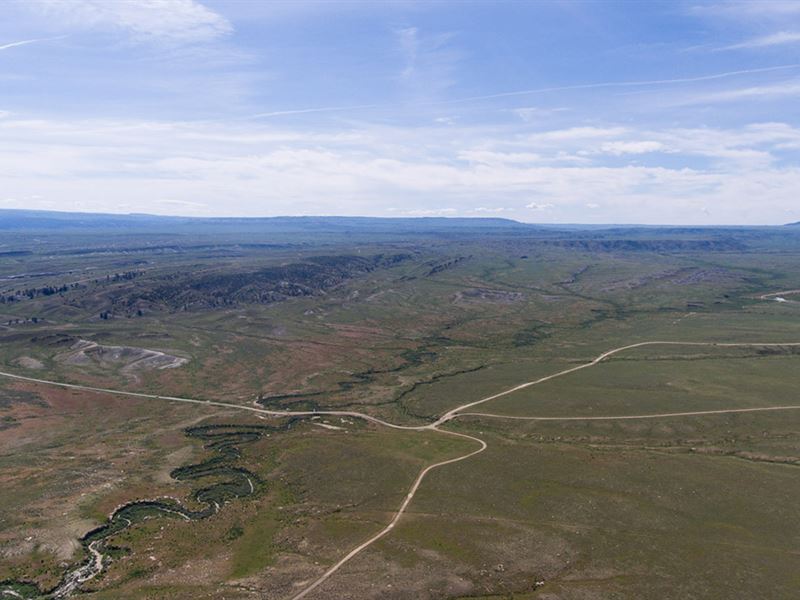The Bureau of Land Management has finalized its purchase of a 35,670-acre ranch southwest of Casper, Wyoming, its largest-ever land acquisition in that State. The Marton ranch, stretching across Natrona and Carbon Counties, has been on the BLM’s wish list for years, and the deal was sealed last year when the Land and Water Conservation Fund provided the $21 million price tag. Local officials, residents, and the State of Wyoming, were shocked at the nationalization of a family ranch that had operated for generations.
The purchase changes the management of a far greater swath of land, because the ranch also includes over 25,000 acres of BLM grazing permits. It has been a dual livestock operation, with nearly 500 head of cattle and some 2,800 sheep. The grazing permit of 3,050 animal-unit-months will eventually be cancelled, of course, the BLM not being in the livestock business, and that affects many others besides one family. For example, neighboring ranches will no longer be able to sell 600-700 tons of hay to the Marton Ranch annually, and the property will no longer be on the local tax rolls.

Wyoming Governor Mark Gordon is challenging the BLM purchase, telling the Interior Board of Land Appeals that the agency showed a “cavalier disregard” for soliciting input from the state, local governments and the public, and that it failed to consider the negative revenue ramifications of transferring the private property into federal ownership. Natrona County alone collects over $10,000 annually from that ranch, and it will affect the County’s federal PILT payment (based on acreage) of $3.8 million annually. The Governor won’t win, though. This horse has already left the barn.
The government says the land was in dire need of “protection,” though it is unclear from what. The federal government already owns 47 percent of Wyoming, 29 million acres, including national forests, national parks, and BLM, along with vast quantities of underlying minerals. So, the claimed need for public access for recreation just doesn’t ring true, nor was there any threat of urban sprawl there.
I have no axe to grind regarding the Marton Ranch, but it leaves many of us wondering, how much government land is enough? The answer is: it depends. It depends upon whether we think environmental values can be safeguarded only if government owns the land. If you believe that, then you must believe the environment will never be fully protected until government owns every square inch of land. But maybe it is not about protecting the environment. The catchphrase “30×30” is a stated goal of the Administration, to “protect” 30 percent of American land by 2030. But the federal government already owns more than half of the Western U.S., so what is the real goal? Buying up the East?
One answer might be suggested by a new report, “Beyond Carbon-Free: A Framework For Purpose-Led Renewable Energy Procurement and Development.” It was published by LevelTen Energy (Seattle), the Nature Conservancy (Washington, DC) and the National Audubon Society (New York City). It suggests that a goal of net-zero carbon emissions by 2050 requires “massive areas of land for development.” It estimates that goal “could require a footprint of 228,000 square miles – a land area greater than that of Wyoming and Colorado, combined. This tremendous need for land poses significant land-use challenges, and the potential for unintended consequences on both local communities and natural habitats.” Yet despite that dire outlook, the report says, “In today’s rapidly evolving energy landscape, this transition looks more achievable than ever.”
It reminds me of another time when Northwest Colorado was considered expendable. The 1974 Arab oil embargo and world energy crisis created an oil shale boom, and President Carter created new agencies and programs to subsidize America to energy independence. The first plan, which seems especially bizarre in retrospect, was to declare Northwest Colorado a “national sacrifice area,” and to create an Energy Mobilization Board with power to override federal, state and local environmental and land use laws so the oil shale could be developed quickly. The plan was a non-starter with political leaders from the West, and it stalled in Congress because of the combined opposition of western senators and the environmental lobby.
Since then, Westerners have often vowed never to be considered a national sacrifice zone again. Yet here we are, unabashedly discussing a plan to acquire more land than Wyoming and Colorado combined, while watching a massive land purchase in Wyoming. Might Wyoming and Colorado have less influence in Washington than the environmental lobby?




Comments on this entry are closed.